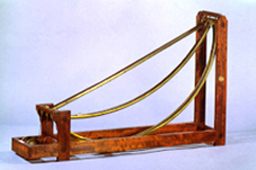
43 x 71 x 13.9
Wood, brass and ivory
CAT. 1824 : E.I.42
Um apparelho, que consta de tres caniculos de latão, um em forma de arco circular, outro cycloidal, e outro em linha recta, pelos quaes podem descer tres spheras de latão, que vão tocar tres campainhas. Serve para mostrar, que os corpos descem mais depressa por arcos cycloidaes, do que por circulares ou por linhas rectas.
An apparatus that consists of three very thin brass channels, one in the form of a circular arc, another cycloidal and the other in a straight line, along which three brass spheres are permitted to descend which will ring three bells. It serves to show that bodies descend faster through the cycloidal arc than through the circular one or the straight line.
This apparatus is for the comparative study of the movement of three spheres that travel along brass channels mounted on a wooden frame. The three possible trajectories have three different configurations; the upper channel is a straight line with a fixed inclination, the middle one takes the form of a cycloid, while the third is in the form of a arc of a circle.
The spheres are released simultaneously, from the highest point of each trajectory. In order to achieve this, the apparatus is equipped with a piece of wood which turns on a horizontal axis, and which is fitted with three grips, each corresponding to one of the channels, which hold the spheres in the initial position. When the piece of wood turns around its axis, the spheres start their movement simultaneously from a resting position. The moment the spheres arrive is marked by the striking of a clapper against a bell.
The order of arrival is as follows; in first place is the sphere that moves along the cycloid channel, in second place is the sphere that moves along the arc of a circle, and in third place is the sphere that moves along the straight line. This result seems somewhat paradoxical, and justification for the sequence does not lie in the different distances that each sphere has to cover during movement. Because of the fact that the starting points, as well as the finishing points, are at the same heights, respectively, the velocities of the spheres at the instant they hit the bell's clapper are equal.
The justification for the order of arrival is based on the difference in the characteristics of the forces exerted by the three channels during the movement. For the cycloid the average value of the horizontal component of this force is greater than that in the other cases, which results in a horizontal component of acceleration of a larger average value.